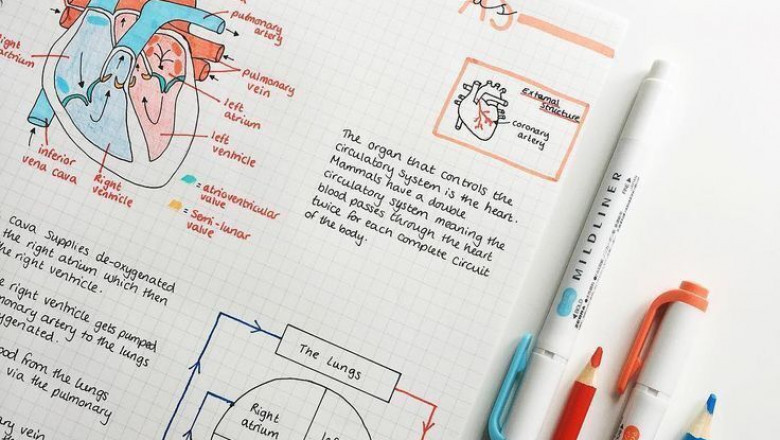views
Class 11 Biology Notes for NEET Preparation
Overview of NEET Biology Syllabus
The NEET Biology syllabus can be broadly classified into two sections: Botany and Zoology, which can further be classified into separate chapters. The syllabus is based on NCERT for classes 11 and 12. The National Testing Agency (NTA) organises the NEET exam.
The syllabus includes subjects like botany, which is the study of plants, and zoology, which is the study of animals, that are essential for learning different biological processes and systems. In the Biology section of the NEET exam, there are a total of 50 questions, out of which 25 are of Botany and the remaining 25 are related to Zoology.
Important Topics for NEET Biology
The topic distribution of NEET Class 11 Biology.
Class 11 Syllabus (Botany and Zoology)
The NEET syllabus 2025 for biology for Class 11 plays a crucial role in the preparation for the NEET exam. Here’s an outline of the NEET syllabus 2025 for biology for Class 11:
Unit 1 – Diversity of Living Organisms
-
Classification and identification of organisms.
-
Five Kingdom Classification: Monera, Protista, Fungi, Plantae, Animalia.
-
Structural and functional characteristics of each kingdom.
-
Concept of species and biodiversity.
Unit 2 – Structural Organisation in Animals and Plants
-
Study of tissues, organs, and systems in plants and animals.
-
Plant anatomy: roots, stems, leaves, flowers.
-
Animal tissues: epithelial, connective, muscular, and nervous tissues.
Unit 3 – Cell Structure and Function
-
Structure of plant and animal cells.
-
Organelles like mitochondria, endoplasmic reticulum, and Golgi apparatus.
-
Cell division: Mitosis and meiosis.
Unit 4 – Plant Physiology
-
Photosynthesis, respiration, transpiration, and plant growth.
-
Transport in plants: xylem and phloem.
-
Mineral nutrition, absorption, and transpiration pull.
Unit 5 – Human Physiology
-
Digestion, respiration, circulation, excretion, and reproduction in humans.
-
Nervous and endocrine systems.
-
Locomotion and movement.
Class 12 Syllabus (Botany and Zoology)
The updated NEET 2025 biology syllabus outlines the important topics and subtopics that students should concentrate on as they prepare for the exam. Here’s an outline of the NEET Biology Syllabus 2025 for Class 12:
Unit 1 – Reproduction
-
Reproductive organs, gametogenesis, fertilisation.
-
Asexual and sexual reproduction in plants and animals.
-
Human reproduction: male and female reproductive systems, menstrual cycle.
Unit 2 – Genetics and Evolution
-
Principles of inheritance and variation.
-
Mendelian genetics, laws of inheritance.
-
DNA replication, transcription, translation.
-
Evolution theories: Darwin’s theory, Hardy-Weinberg principle.
Unit 3 – Biology and Human Welfare
-
Human health and diseases: Immunity, AIDS, cancer, and microbial diseases.
-
Agriculture: Crop production and management, animal husbandry.
-
Biotechnological applications in medicine and agriculture.
Unit 4 – Ecology and Environment
-
Ecosystem, energy flow, food chains, and webs.
-
Biogeochemical cycles: carbon, nitrogen, and water cycles.
-
Environmental pollution and conservation of biodiversity.
Class 11 Biology Chapter-wise Notes for NEET Preparation
Preparing for NEET demands a deep understanding of these concepts, so here's a detailed guide for Class 11 Biology notes to help you in your NEET preparation.
Unit 1 – Diversity of Living Organisms
1.1 Biological Classification
Biological classification is the arrangement of organisms into categories based on their similarities and differences. It is important for understanding the diversity of life forms. The five-kingdom classification proposed by Robert Whittaker includes:
-
Monera: Prokaryotic organisms such as bacteria.
-
Protista: Eukaryotic, mostly unicellular organisms like amoeba and paramecium.
-
Fungi: Non-photosynthetic, multicellular organisms like mushrooms and moulds.
-
Plantae: Multicellular, photosynthetic organisms such as mosses and trees.
-
Animalia: Multicellular, heterotrophic organisms like humans and mammals.
1.2 Taxonomy and Systematics
Taxonomy deals with the identification, nomenclature, and classification of organisms. Systematics is a branch of biology that focuses on the evolutionary relationships between organisms. The binomial nomenclature system, introduced by Linnaeus, is used to name species using two names: genus and species (e.g., Homo sapiens).
Unit 2 – Structural Organisation in Animals and Plants
2.1 Plant Tissues
Plants have various types of tissues, each with specific functions:
-
Meristematic Tissue: Responsible for growth and cell division. Found at the tips of roots and shoots.
-
Permanent Tissue: Includes:
-
Simple Tissue: Parenchyma (storage), Collenchyma (support), and Sclerenchyma (strength).
-
Complex Tissue: Xylem (water transport) and Phloem (food transport).
2.2 Animal Tissues
Animals also possess specialised tissues:
-
Epithelial Tissue: Covers body surfaces and organs. Types include squamous, cuboidal, columnar, and ciliated epithelium.
-
Connective Tissue: Includes blood, bone, cartilage, and lymph, providing support and transporting nutrients.
-
Muscle Tissue: Responsible for movement, including skeletal, smooth, and cardiac muscles.
-
Nervous Tissue: Composed of neurones that transmit electrical impulses.
2.3 Digestive System in Humans
The human digestive system includes the mouth, oesophagus, stomach, small intestine, large intestine, and anus. It breaks down food and absorbs nutrients.
-
Mouth: Mechanical and chemical digestion begins here.
-
Stomach: Enzymatic breakdown of proteins.
-
Small Intestine: Primary site of digestion and nutrient absorption.
-
Large Intestine: Absorbs water and salts, forming faeces.
Unit 3 – Cell Structure and Function
3.1 Cell Theory
The cell theory was proposed by Schleiden and Schwann. It states that:
-
All living organisms are composed of cells.
-
The cell is the basic unit of life.
-
All cell functions are essential for the organism’s survival.
3.2 Cell Organelles
-
Nucleus: Contains genetic material (DNA), controlling cell activities.
-
Mitochondria: Powerhouses of the cell, generating ATP.
-
Endoplasmic Reticulum (ER): Rough ER has ribosomes and synthesises proteins, while smooth ER synthesises lipids.
-
Golgi Apparatus Modifies, sorts, and packages proteins.
-
Lysosomes: Contain enzymes for digestion.
-
Plasma Membrane: Semi-permeable membrane that regulates the entry and exit of substances.
3.3 Transport Across the Cell Membrane
-
Diffusion: Movement of molecules from high to low concentration.














Comments
0 comment